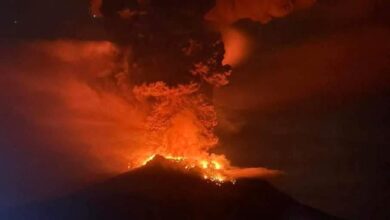Russia Moon probe disaster may have produced a 33-foot-wide lunar crater, according to NASA pictures
According to NASA, when Russia’s Luna-25 probe lost control and crashed on the moon’s surface last month, it probably left a 33-foot-wide crater on the lunar surface. The first lunar trip for Russia in over 50 years ended in failure on August 19. The lunar crater may be seen in several NASA pictures.
According to Roscosmos, the Russian space agency, the incident happened when a thruster firing went off course, resulting in a loss of contact and an inaccurate orbital trajectory.
The Lunar Reconnaissance Orbiter (LRO) satellite of NASA recently took pictures of what it called a “fresh crater.” Roscosmos announced an estimate of the probe’s impact site before these pictures were collected.
According to NASA, “the LRO team deduces that it is probably a result of that mission, as opposed to a naturally occurring impact” because of its closeness to the predicted Luna-25 impact point.
On August 24, the LRO crew used the Lunar Reconnaissance Orbiter Camera (LROC) to take pictures of the region. They then performed a comparison study, comparing the most current LROC photos of the area with earlier NASA images of the same region, the most recent of which date back to June 2022. This investigation revealed the existence of a recently formed, bright crater on the moon that is thought to have developed during the last 14 months.
The goal of Luna-25 was to perform a soft landing in the region of the moon’s southern pole, which is thought to be rich in water ice and has the ability to support human habitation.
However, Chandrayaan-3, an Indian mission that launched on July 14 and successfully landed on August 23, now has this distinction after Luna-25’s mishap. Currently, Chandrayaan-3 is using a lander and a small rover to explore its polar position. These instruments were designed to last for a full lunar day, which is roughly similar to 14 Earth days. After this time, when lunar darkness sets in, it is projected that both robotic systems would become unusable.
The duty of conducting a comprehensive inquiry into the specific reasons of the Luna-25 probe’s accident has been assigned to a committee that Moscow has set up.
This mission’s failure was a major setback for the Russian space program, which had been working to improve its capabilities, particularly in view of the resurgence of curiosity over the southern polar area of the moon. This area may include ice deposits in persistently shaded craters, a resource that might be very useful for future space missions by providing a way to produce breathing air, drinkable water, and possibly hydrogen rocket fuel.
Since the Luna-24 robot’s lunar landing in 1976, when it successfully gathered and returned around six ounces of lunar soil to Earth, Russia’s track record in autonomous space exploration has seen scant success. This was the country’s third successful robotic lunar sample return mission.
In comparison, the United States saw the landing of twelve astronauts on the moon half a century ago thanks to the Apollo program. Strangely, no Russian cosmonaut has ever made such a trip. Furthermore, Russia’s past post-Soviet Mars-focused deep space robotic missions were unsuccessful.







